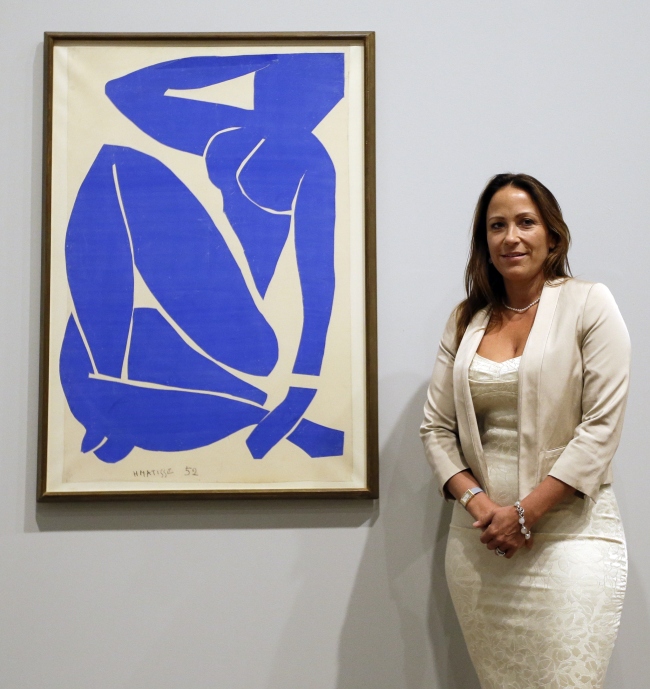LONDON (AP) ― A huge new Henri Matisse show in London is many things ― bold, colorful, exuberant. It’s also a great advertisement for the creativity of old age.
The 130 works displayed at Tate Modern were created largely in the last decade of the French artist’s long life, when Matisse ― in a wheelchair, recovering from cancer and unable to paint as he once had ― used scissors and paper to create a series of big, bold and ambitious cutouts.
The work of a man in his late 70s and 80s, they burst with vitality. They include the famous blue nudes ― lithe-limbed female forms, cut in a single movement from blue-painted sheets of paper. The biggest works, such as the richly patterned “Large Composition with Masks” and blocky abstract “The Snail,” cover whole walls of the gallery with dollops of vivid color.
“You can’t walk out of here without being in a good mood,” the artist’s great-granddaughter Sophie Matisse said Monday, sitting in front of “The Parakeet and the Mermaid,” a multicolored burst of foliage.
These life-affirming works were created out of a sense of mortality, by an artist who had undergone major surgery for cancer in 1941. Matisse died in 1954 at the age of 84.
“He was very close to the end of his life and there were more things that he wanted to do,” said Sophie Matisse, a New York-based artist. “He felt that the clock was ticking, so to speak, and he didn’t have a lot of time to say what he wanted or to do what he wanted.”
 |
Sophie Matisse, the great-granddaughter of Henri Matisse, stands alongside his work “Blue Nude III 1952” at the Tate Museum in London on Monday. (AP-Yonhap) |
What he wanted, she said, was to create three-dimensional works that leapt off the wall, driven by an “almost futuristic” desire to transcend the limits of canvas and frame.
Matisse initially used paper cutouts to plan paintings, illustrations and large works such as tapestries and set designs. But what started out as a planning tool ― one he kept secret from the outside world ― became an artistic medium in itself.
Soon he was covering the walls of his studio with bits of paper in blue, red, yellow, green, orange, white and black. He cut them into shapes ― leaves, petals, swirls ― and into animal and human figures.
“Most artists develop a late style,” said curator Nicholas Cullinan. “But Matisse instead invented a new medium.” Co-curated with the Museum of Modern Art in New York ― where it will move in October ― the show is the biggest-ever exhibition of Matisse’s paper works, and is sure to be a hit. It could surpass the 2002 show “Matisse Picasso” as Tate Modern’s best-selling exhibition.
Works have been borrowed from museums and private collections around the world for the show, which sees the four major blue nudes displayed together in Britain for the first time.
Also included are the cutout illustrations Matisse made for the book “Jazz,” published in 1947. Among them is one of the artist’s most famous images, “Icarus” ― a black figure surrounded by stars in a blue sky.
One room contains plans for the windows and walls of the chapel Matisse designed in Vence, southern France, where he lived for several years.
By setting preparatory models and film footage of Matisse in his studio alongside finished works, the exhibition reveals an artist who worked intensely until the end of his life ― helped by assistants whom he sent up ladders with pincushions strapped to their wrists and hammers around their necks, to pin cutouts to the walls.
In old age, Matisse drew inspiration from memories of a trip to Tahiti he had made in 1930, as well as from the bright colors of his Mediterranean home. Tate director Nicholas Serota said Matisse’s bold and colorful vision helped change the course of 20th-century art.
“Much of this came immediately after the war, at a time when the prevailing mood was somewhat depressed,” Serota said. “And there was Matisse ... (conjuring) up these astonishing compositions with vibrant color and enormous sophistication.”
Serota said he hoped the exhibition would help visitors reassess their ideas about Matisse, who is often seen as a less challenging artist than contemporaries such as Pablo Picasso.
“I think that they will possibly feel that a figure who is always presented as a rather conservative figure actually was much bolder, much freer,” Serota said. “He’s often contrasted with Picasso, who was always out there proclaiming novelty ― whereas Matisse somehow achieved novelty.”
“Henri Matisse: The Cutouts” opens Thursday and runs to Sept. 7 at Tate Modern. It runs at the Museum of Modern Art in New York from Oct. 14 to Feb. 9.






![[Exclusive] Hyundai Mobis eyes closer ties with BYD](http://res.heraldm.com/phpwas/restmb_idxmake.php?idx=644&simg=/content/image/2024/11/25/20241125050044_0.jpg)
![[Herald Review] 'Gangnam B-Side' combines social realism with masterful suspense, performance](http://res.heraldm.com/phpwas/restmb_idxmake.php?idx=644&simg=/content/image/2024/11/25/20241125050072_0.jpg)
